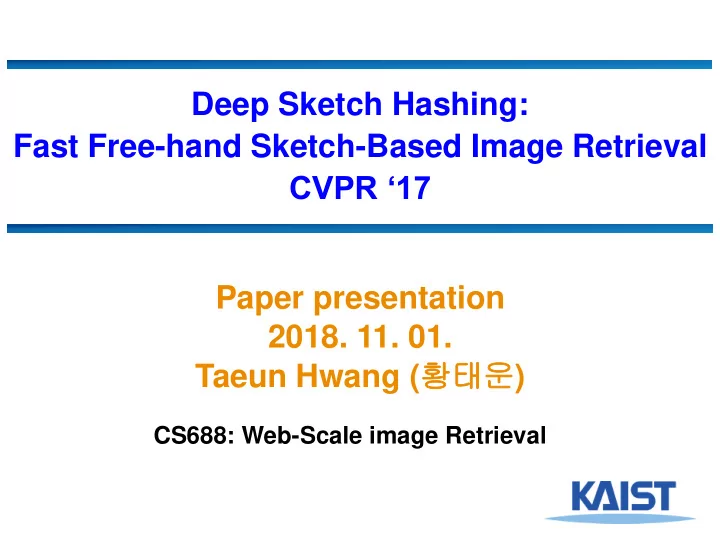

Deep Sketch Hashing: Fast Free-hand Sketch-Based Image Retrieval CVPR ‘17 Paper presentation 2018. 11. 01. Taeun Hwang ( 황태운 ) CS688: Web-Scale image Retrieval
Review ● SuBiC: A supervised, structured binary code for image search[ICCV 2017] presented by Huisu Yun ● Very long Raw feature vectors binary code ● Code length in the SuBiC : KM ● actual storage can be easily reduce to M log 2 K ● One hot code block M additions for distance computing 2
Contents ● Introduction ● Main Idea ● Method ● Experiment & result 3
Introduction 4
Introduction ● Sketch-Based Image Retrieval ● Image retrieval given freehand sketches illustration of the SBIR 5
Challenges in SBIR ● Geometric distortion between Sketch and Natural image ● IE) backgrounds, various viewpoints… sketch natural image ● Searching efficiency of SBIR ● Most SBIR tech are based on applying NN ● Computational complexity O(Nd) ● Inappropriate for Large-scale SBIR 6
Main Idea ● Geometric distortion ● diminish the geometric distortion using “sketch - tokens” ● Speeds up SBIR by embedding sketches and natural images into two sets of compact binary codes ● In Large-scale SBIR, heavy continuous-valued distance computation is decrease 7
DSH: Method Deep Sketch Hashing(DSH): Fast Free-hand Sketch-Based Image Retrieval 8
Sketch token : background ● Sketch tokens: A learned mid-level representation for contour and object detection [JJ Lim et al., CVPR ’13] ● Sketch-token : Hand-drawn contours in images 9
Sketch token : background ● Sketch-tokens have similar stroke patterns and appearance to free-hand sketches ● Reflect only essential edges of natural images without detailed texture information ● In this work : used for diminish geometric distortion between sketch and real image 10
Network structure ● Inputs of DSH 11
Network structure ● Semi-heterogeneous Deep Architecture ● Discrete binary code learning Semi-heterogeneous Deep Architecture 12
Network structure ● C1-Net (CNN) for Natural image ● C2-Net (CNN) for sketch and sketch-token 13
Semi-heterogeneous Deep Architecture ● Cross-weight Late-fusion Net 14
Semi-heterogeneous Deep Architecture ● Cross-weight Late-fusion Net Connect the last pooling and fc layer with Cross-weight [S Rastegar et al., CVPR’16] Maximize the mutual inform across both modalities , while the information from each individual net is also preserved 15
Semi-heterogeneous Deep Architecture ● Cross-weight Late-fusion Net Late-fuse C1-Net and C2-Net into a unified binary coding layer hash_C1 the learned codes can fully benefit from both natural images and their corresponding sketch-tokens 16
Semi-heterogeneous Deep Architecture ● Shared-weight Sketch Net 17
Semi-heterogeneous Deep Architecture ● Shared-weight Sketch Net Siamese architecture for C2-Net(Top) and C2-Net(Middle) consider the similar characteristics and implicit correlation s existing between sketch-tokens and free-hand sketches 18
Semi-heterogeneous Deep Architecture ● Shared-weight Sketch Net Binary coding layer hash_C2 hash codes of free-hand sketches learned shared-weight net will decrease the geometric difference between images and sketches during SBIR. 19
Semi-heterogeneous Deep Architecture ● Result : Deep hash function B B S = sign(F 2 (A)) B I =sign(F 1 (B, C)) A = weights of C2(Top) : Sketch B, C = weights of C2(Middle),C1 : Sketch-token, natural image 20
Discrete binary code learning ● There are two loss function ● Cross-view Pairwise Loss ● Semantic Factorization Loss 21
Discrete binary code learning ● Cross-view Pairwise Loss ● denotes the cross-view similarity between sketch and natural image ● The binary codes of natural images and sketches from the same category will be pulled as close as possible (pushed far away otherwise) 22
Discrete binary code learning ● Semantic Factorization Loss : Word embedding model Y : label matrix ● Consider preserving the intra-set semantic relationships for both the image set and the sketch set ● Using Word2Vector, consider distance of label’s semantic 23
Discrete binary code learning ● Semantic Factorization Loss : Word embedding model Y : label matrix ● The semantic embedding of “cheetah” will be closer to “tiger” but further from “dolphin” 24
Discrete binary code learning ● Final Objective Function ● Cross-view Pairwise Loss + Semantic Factorization Loss 25
Optimization (training) ● The objective function is non-convex and non- smooth, which is in general an NP-hard problem due to the binary constraints ● Solution : sequentially update parameters ● param : D, BI, BS and deep hash functions F1, F2 The illustration of DSH alternating optimization scheme 26
Test ● Given sketch query B S = sign(F 2 (A)) ● Compare the distance with B I ’s in retrieval database 27
Result 28
Experiments ● Data set ● TU-Berlin Extension, Sketchy ● All image has relatively complex backgrounds ● Top-20 retrieval results (Red box : false positive) 29
Result ● Comparison on other SBIR methods 30
End 31
Recommend
More recommend